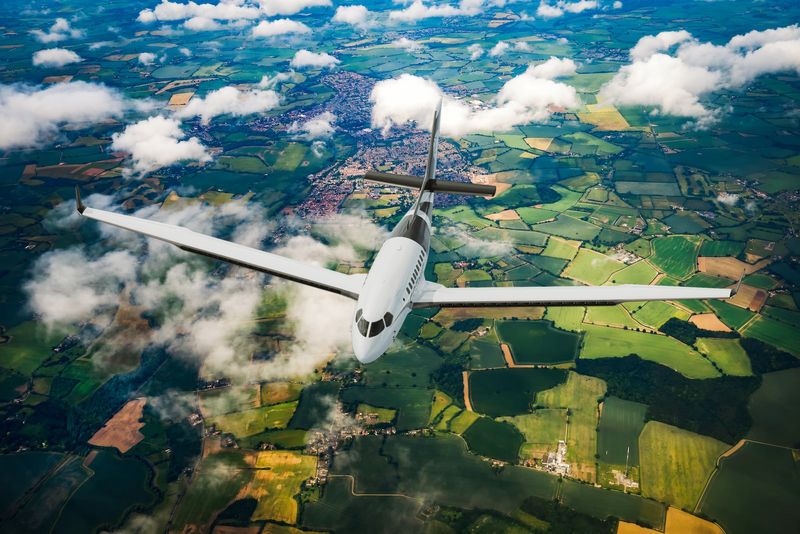32 Motors across a long Wing
Cosmic Aerospace has announced a different kind of “blown wing,” hiding 32 specially developed electric turbines across the inner span of a high-aspect-ratio wing. Cosmic will attempt to achieve jet-like speeds at half the cost of fossil-fuel or sustainable aviation fuel (SAF) powered jet.
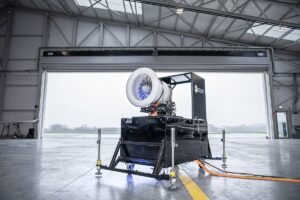
Motor under test in hanger at Limburg Regional Airprt, Belgium
Electric-flight.eu notes the American-Belgian firm was founded by “graduates of Boom Supersonic, NASA, Oxford and Kittyhawk,” a broad spectrum of talent. Part of that team is creating a fully-electric “jet engine,” currently under test at Limburg Regional Airport in Belgium.
The motors will be fed by packs of 360-Watt-hour per kilogram batteries, achievable with today’s technology. This enables up to 1,000 kilometer (600 mile) range for a long-winged craft carrying 24 passengers. “Unlike other startups in the field, which are mostly focused on sustainable jet fuels, hydrogen, and battery tech, Cosmic has focused its engineering efforts on better propulsion systems and a unique air frame design, CEO Christopher Chahine told CNBC.” He might have added that it’s a rarity for a company to build the airframe and the propulsion system.
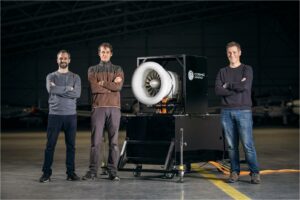
Cosmic Aerospace leadership team: (L-R: CEO Christopher Chahine, CTO Marshall Gusman and Chief Engineer Joe Wilding
Beyond the innovative electric jet engine, Cosmic arrays 16 on each half of its long wing. This distributed electric power also distributes the weight of all those motors across a good portion of the total span, alleviating the load on the mid-span area. This should allow for a lighter spar and associated structural elements. Cosmic claims an “incredibly light structure” helps achieve “a long span without a weight penalty.” Such lightness helps offset the inevitable weight of even light batteries. The possibilities inherent in a blown wing may surpise future observers.

32 motors wthin wing pull in air at teh leading edge and exhaust it at the trailed edge, much like the Bartoe-Ball craft described below.
Cosmic claims the Slylark is ready for transonic flight on today’s batteries, “no battery miracles needed.”
$4.5 Million Seed Funds
Impatience can be a virtue. Tech.eu notes Cosmic CEO Christoper Chahine’s background may have led to $4.5 million in early funding. “Led by Christopher Chahine, a distinguished research and development engineer and doctor hailing from the von Karman Institute for Fluid Dynamics and the University of Oxford, the foundations of Cosmic Aerospace lie in Chahine’s impatience with the speed of development when it comes to sustainable aviation.
“Chahine shared: “I felt that, despite the knowledge that aviation emissions were an urgent and growing problem, the industry shied away from taking the bold steps needed to explore solutions that are both commercially viable and capable of delivering impact in the near future.”
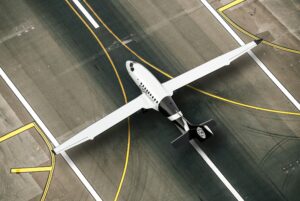
Skylark shows long, hight-aspect ratio wings, powered out to the tapered tips
Pale blue dot led funding with Aera VC, Visionaries Club Tomorrow, Fifty Years, Possible Ventures, Syndicate One, Course Corrected, Understorey Capital and Samurai Incubate participating.
Cosmic announced additional good news in early January. “We are delighted that Cosmic has been selected as one of the finalists of the Hello Tomorrow Global Challenge, a world-renowned deep tech startup competition, joining 70 finalists out of a total of 4,500 applicants. We are looking forward to pitching at the Hello Tomorrow Global Summit in March.”
A Possible Historical Predecessor
Your editor doesn’t think it’s mere coincidence that Cosmic Aerospace is located near Denver, site of the Wings Over the Rockies Aviation Museum.
The Museum explains this odd airplane here, and although the blown wing technologies may be different between it and the Skylark, the possible inspiration seems difficult to dismiss, at least according to your editor.
“Pete Bartoe designed and built the one-of-a-kind JetWing in the mid-1970s. The first test flights were in 1977, and it retired in 1978. The tiny jet flew again briefly in the early 1980s, and came to Wings Over the Rockies in 2007.
‘This small, single-seat research aircraft explored the technology of increasing lift at low speeds by blowing the exhaust of the turbofan engine over the upper surfaces of the wings.
“Airplanes get lift from airflow over and under their wings. Below a certain airspeed, there’s not enough airflow to support the airplane, but lift can be increased by blowing air over the wings.
Being able to fly safely at a low airspeed enables airplanes to take off and land in shorter distances and on rougher surfaces. Many valuable technologies have been developed to allow airplanes to have a high top speed and relatively low landing speed. These include flaps, slats, slots, leading edge devices, speed brakes, and variable-geometry swing-wings.
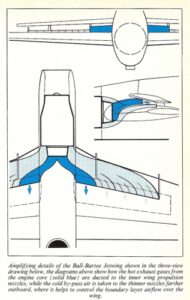
Ball-Bartoe flow diagram shows airflow over and through wing
“Engineers had experimented with blowing jet engine airflow over airplane wings or flaps since the 1940s and 50s, but Bartoe’s design differed by directing all of the engine’s output to the wings. This resulted in an aircraft with an astonishing speed range, from a minimum of 40 mph to a maximum of about 400 mph! Its top speed was ten times its minimum speed! (Even today, most jets—airliners, fighters, transports, and bombers—take off and land at airspeeds between 150 and 200 mph.)”
We’ll have to wait to see how well the Skylark performs. Let’s hope it’s as successful as the Bartoe-Ball craft. Will it share some of that design’s low-speed characteristics?
Aircraft specifications:
Wingspan: 21 ft 9 in (6.63 m)
Length: 29 ft (8.84 m)
Maximum weight: 3,336 lbs (1,513 kg)
Engine: Pratt & Whitney Canada JT15D-1 turbofan
Thrust: 2,200 lbs (9.8 kN)

